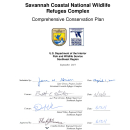What We Do
Wildlife conservation is at the heart of the National Wildlife Refuge System. It drives everything on U.S. Fish and Wildlife Service lands and waters managed within the Refuge System, from the purposes for which a national wildlife refuge national wildlife refuge
A national wildlife refuge is typically a contiguous area of land and water managed by the U.S. Fish and Wildlife Service for the conservation and, where appropriate, restoration of fish, wildlife and plant resources and their habitats for the benefit of present and future generations of Americans.
Learn more about national wildlife refuge is established to the recreational activities offered to the resource management tools used. Using conservation best practices, the Refuge System manages Service lands and waters to help ensure the survival of native wildlife species.
Invasive Species Control
In recent years, invasive, exotic plants have become a serious threat to wildlife refuges throughout the United States. Each year, three million acres of land are lost to invasive plants, and billions of dollars are spent battling their infestation. Chinese tallow tree, water hyacinth, and alligator weed are species from somewhere else – often from another continent – that have been introduced locally. They reproduce rapidly, have few predators, and offer little food value for wildlife. The invasives have infested many impoundments on the refuge, and are major problems for refuge managers.
Prescribed Fire
Fire has shaped the local landscape for eons. Because of the coast's long history of lightning and man-made fires, natural systems are adapted to fire and depend on frequent fire to remain healthy. Prescribed burning plays a natural role in local ecosystems and is a vital tool for managing public lands. The extraordinarily high plant species diversity of the coastal ecosystems is maintained by fire, which reduces competition from woody plants and recycles nutrients. One of the greatest benefits of prescribed fire is that it reduces “fuels” – the underbrush, branches, pine needles, leaves, and dead plant debris that have built up on the forest floor over time. If fuels are not reduced every few years, wildfires can become intense, extremely hot, and destructive.
Management and Conservation
Refuges deploy a host of scientifically sound management tools to address biological challenges. These tools span active water management to wilderness character monitoring, all aimed at ensuring a balanced conservation approach to benefit both wildlife and people. At this field station our conservation tool box includes:
Planning – Comprehensive Conservation Plan
Compatibility Determinations
Cultural Resources
Education & Outreach
Fire Management
Invasive Species
Inventory and Monitoring
Law Enforcement
Recreation Management
Species Research
Water Management

